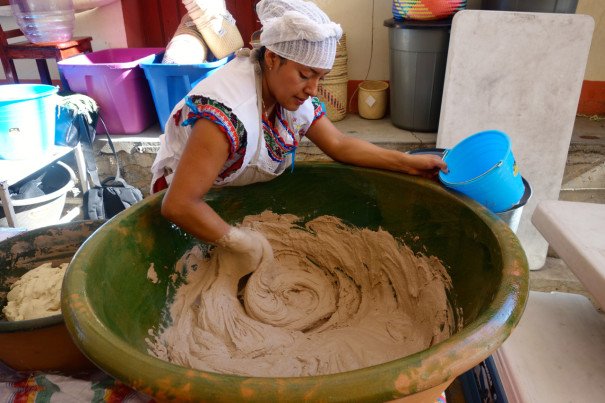
A Hundred Ladies Stirring Chocolate Drinks

A Hundred Ladies Stirring Chocolate Drinks
Tejate in Oaxaca
I’m hot and sweaty, up against the crowd filing through the entrance to the Tlacolula market, and my boyfriend’s mezcal hangover looks like it might finally take him down. Live turkeys are dangling by the neck, the smell of freshly cut pineapple drifts past us, and then the streaming bulbs of chorizo part. There’s a woman standing behind a clay tub with a crowd of people drinking something around her. “We need to get some of that,” I say.
It’s tejate—a drink made by grinding nixtamalized corn, toasted cacao, mamey seeds, and rosita de cacao, a fragrant flower from the funeral tree (that actually has no relation to cacao). White curds sit at the top from kneading the wet dough to a grainy, light consistency. The woman asks us how much simple syrup to add and then she pours the light brown liquid into a jicara cup, a dried gourd from the calabash tree hollowed and painted cherry red.
“It’s very nutritious too,” she says, which I later repeat to myself when going back for two more cups of what tastes like cold, perfumy chocolate milk.
Drinking chocolate in Oaxaca dates back to pre-Hispanic times, and for the elite Mixtecos and Zapotecs it was a ritual during celebrations. Oaxaca was smack in the middle of the cacao trade route, which probably contributes to its diversity of chocolate drinks even though little cacao is grown here. There are about 12 recorded variations, more than anywhere else in Mexico.
These days, tejate is just another staple in the central valley still made by mostly Zapotec women, and, like mezcal, flexes flavors that are bold, ancient, addicting. They call it the beverage of the gods because it’s a genius combination of ingredients meant to keep us mortals going: the maize is cooked in ash or lime to retain its nutrients, the cacao provides a high, and serving it over ice paused our hangover sweats, at least for a minute.
I left the market that day with cheap hairbands, mangos, and a plan to return to learn more about tejate and the 4,000-year-old indigenous food traditions on Oaxaca’s street corners.
I got back to Oaxaca a month later, right before Easter, for the annual Tejate Fair in San Andres Huayapam, a town that’s grown the rosita de cacao since the sixteenth century.
“Esa madre?” a Oaxacan friend said when I told him I wanted to go to the festival (madre technically meaning mother, but in Mexican slang meaning something like “that thing?”) “It’s just a hundred ladies stirring chocolate drinks and selling the same thing.”
The evening before the festival, I walked behind the yellow church under the rosita de cacao trees as women carried buckets from the molino, the mill, where their ingredients are ground instead of the old-fashioned way of hand-grinding on a stone metate. But the tejateras, as they’re called, are still working hard: in the early morning, before the festival starts and the smells of barbacoa fill the streets they’re swirling the dough for hours and adding water until it thins.
All 150 of them. My friend is right: except for the few vendors with the coconut tejate, they’re all selling the exact same drinks. How one would choose who to spend their ten pesos on is beyond me.
I head towards a booth and meet Marisela, who says she’s been making tejate for 30 years, and her mom made it before that. I ask her what makes one tejate different from another.
“Each person has their touch. It’s all about how they roast the ingredients and the exact mixture,” she says.
I wander over to the booth on the corner of the church and buy a cup. It tastes about the same as the last one, but it’s still good and I drink it all.